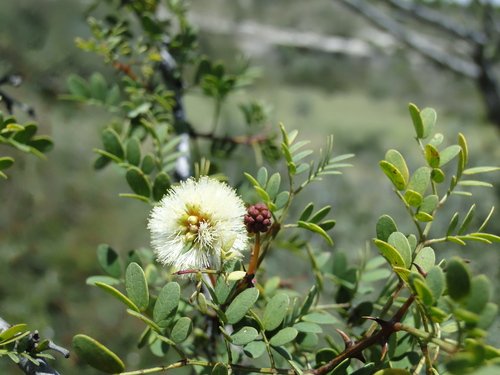Roundflower Catclaw
Senegalia roemeriana
Family: Fabaceae
OTHER NAMES
Roemer acacia, roundflower Catclaw, catclaw Acacia
CHARACTERISTICS
This is a prickly, 3-7 ft., round-topped shrub or, more rarely, a small tree to 20 ft. with spreading branches. Branchlets with scattered straight or recurved spines. Fragrant, cream flowers occur in spring followed by brown to reddish, flat, curved pods.
LANDSCAPE USE
Screening shrub or small tree
GROWING CONDITIONS
AN EXPLANATION OF TERMS USED
SUN this plant looks its best planted in full sun but can take part sun or shade as well
WATER low to moderate water, can live on rainfall when established but may not get tree-sized on rainfall
SOIL native to bosques, but tolerates most soils
HARDINESS hardy to 15°F
BASIN low to terrace zones
CONTAINER this plant does moderately well in containers but is very thorny and not good for high traffic areas. Will not reach potential size in container
NUTRITION moderate
MAINTENANCE prune thorny branches out of walkways
ECOLOGY
The flowers are extra nectar-rich and attract a load of butterflies, bees, and more. Butterfly larval food plant for the Mexican yellow (Eurema mexicana), the Mimosa yellow butterfly (Eurema nise), the Reakirt’s blue (Echinargus isola), and the marine blue (Leptotes marina). Moth larval food plant for Hubbard’s small silkmoth (Sphingicampa hubbardi), tricolor buckmoth (Hemileuca tricolor), black witch moth (Ascalapha odorata), mesquite stinger flannel moth (Norape tenera), naval orange worm moth (Amyelois transitella), the merry melipotis moth (Melipotis jucunda) and many others. Attracts substrate-insectivorous birds. Some species consume seeds as well. Flowers attract all sorts of nectar-eating insects. Nice habitat for birds (the dense, thorny branches protect animals hiding within).
ETHNOBOTANY
Wood used for constructing various items. Great nectar plant for domestic bees. Young, green seed pods roasted and ground into meal, often mixed with fats or oils. Dried pods are avoided because they contain a cyanogenic glycoside, called prunasin. Leaves, stems, pods, and roots are used as an astringent, emollient, disinfectant, anti-inflammatory. Sometimes used in basketry. A gum similar to gum arabic exudes from the trunks of older plants and has been used.
NATURAL DISTRIBUTION
Native to central, southern, and western Texas, and southeatern New Mexico, and also in northeastern Mexico. It is found in grassland, woodland, and thornscrub on slopes, valley, and along arroyos.
TAXONOMY AND NAME
Formerly known as Acacia roemeriana.
This species is in the Fabaceae, legume family. The genus Senegalia has 226 accepted species worldwide.
Acacia is from Greek akakie taken from ake or akis, -a sharp point. The genus Senegalia is a derivation of Senegal in Africa. The species epithet, roemeriana, is named in honor of Ferdinand von Roemer, (1818-1891), a German geologist who lived in Texas from 1845 to 1847 and became known as the "father of Texas geology".

Flower closeup, photo by Zona Sujeta a Conservación Ecológica Sierra de Zapalinamé, iNaturalist

Seed pods follow the flowers, photo by Bryan, iNaturalist

